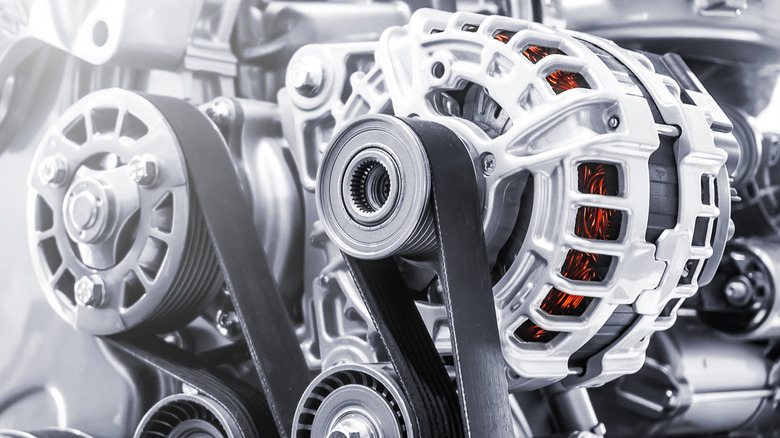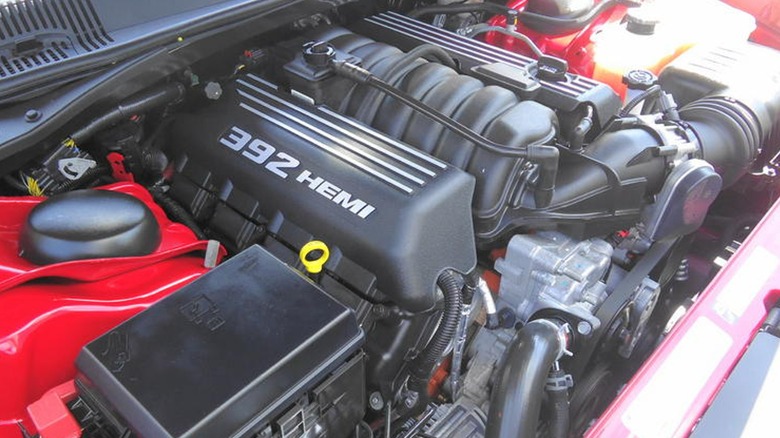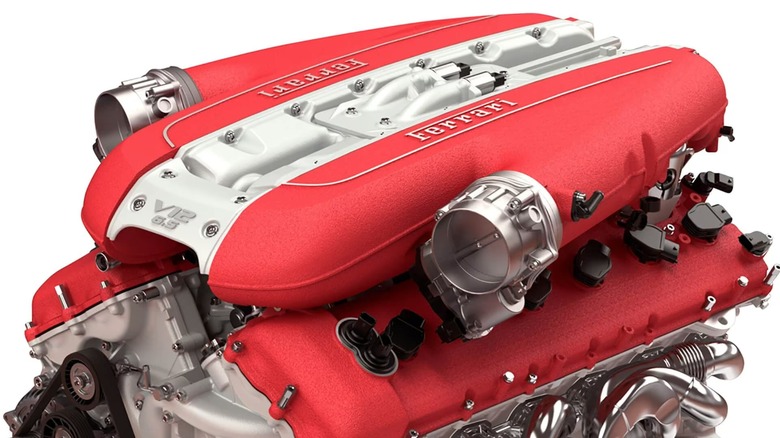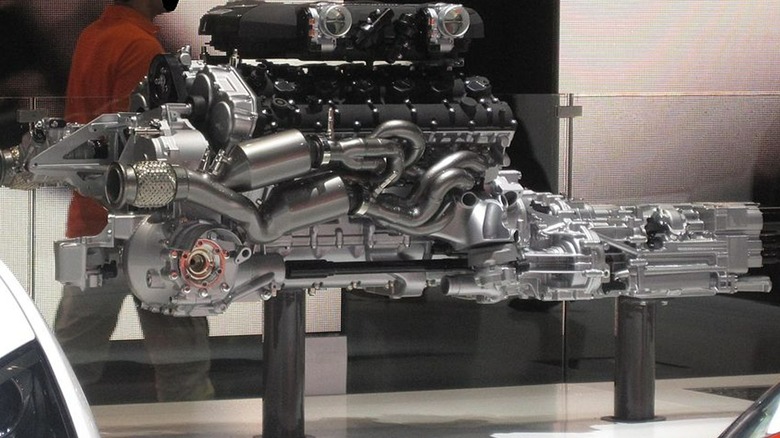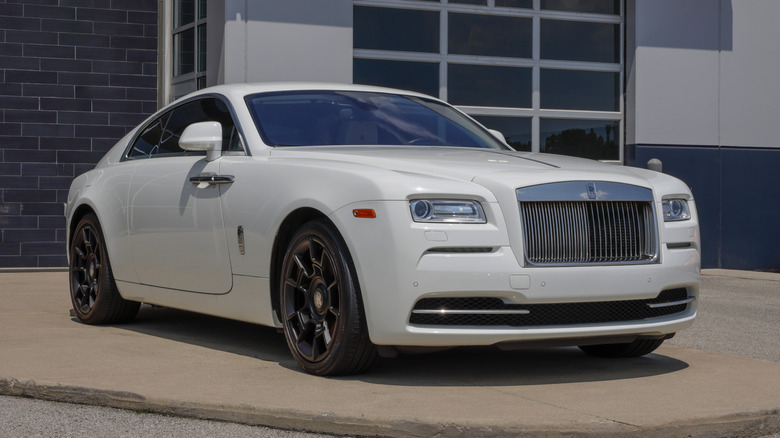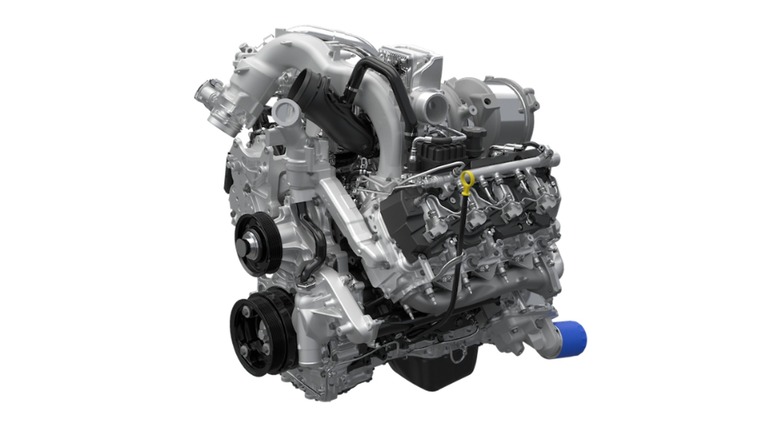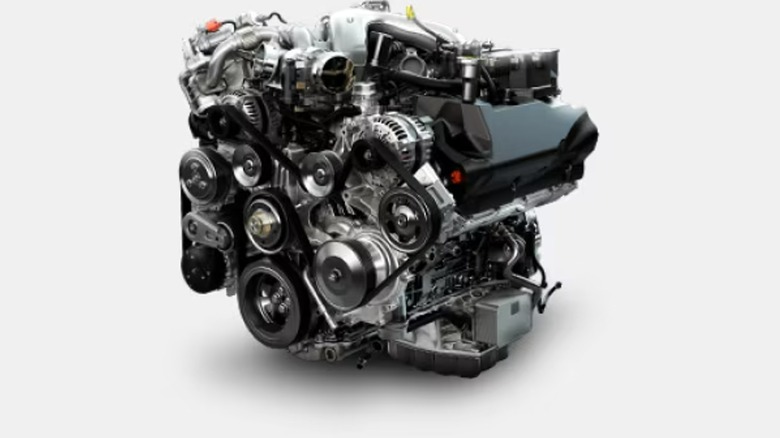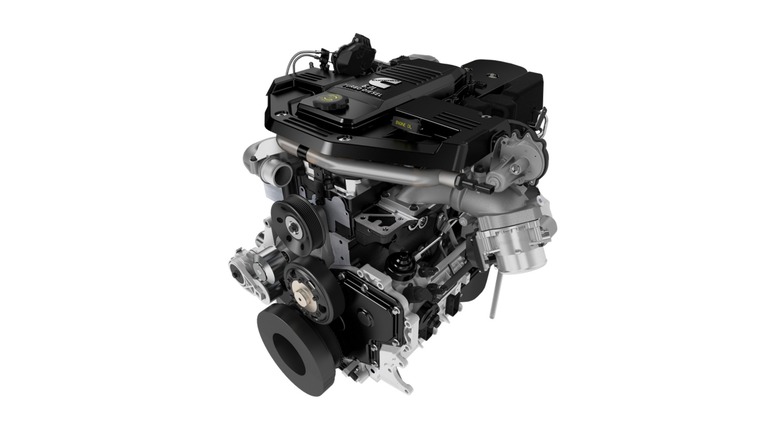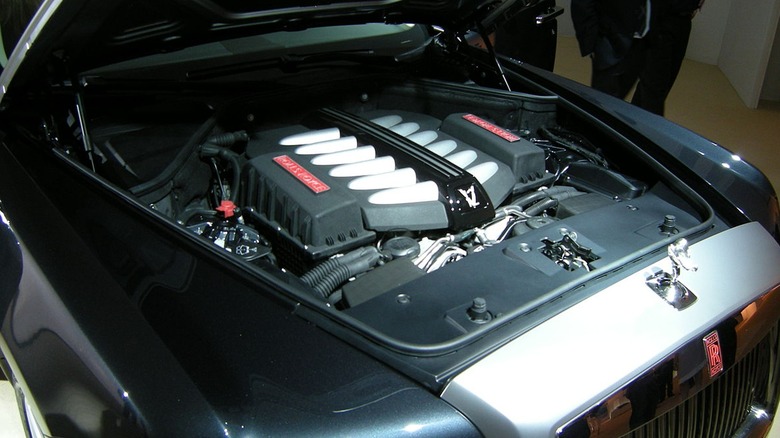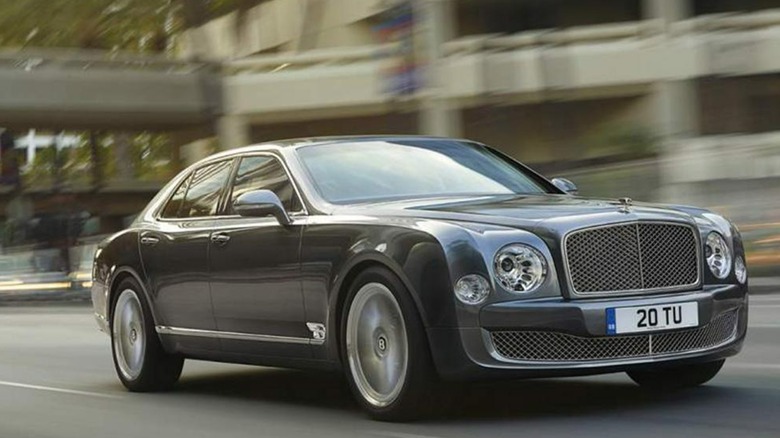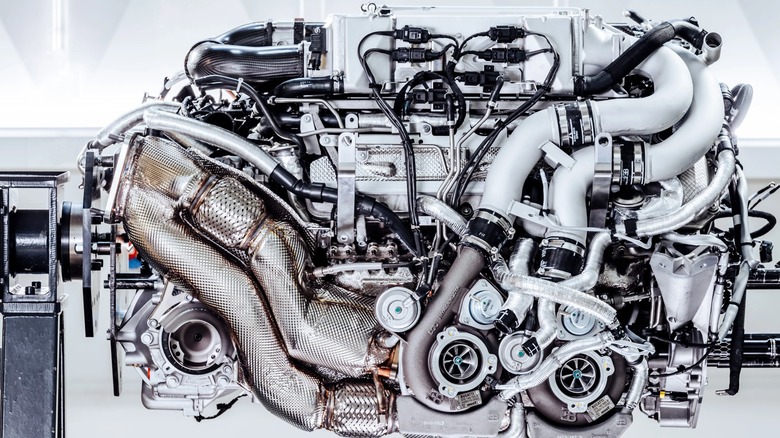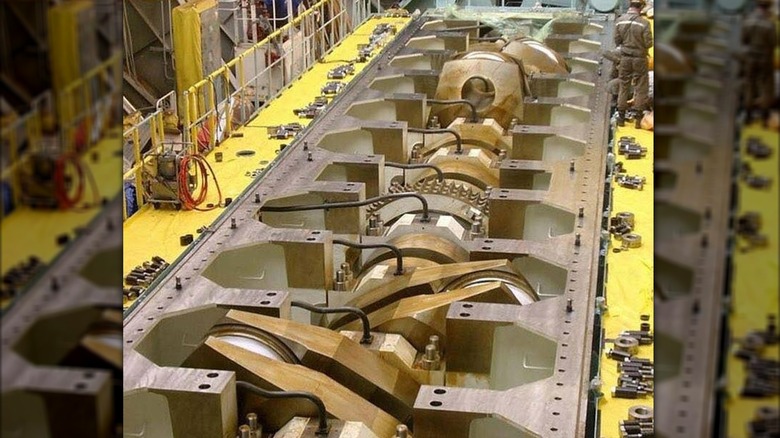11 Of The Largest-Displacement Engines In Production Today
Everyone loves a mammoth engine. From the rumble it creates with the key in the ignition to the incredible get up and go that a gigantic engine offers, either as a towing solution or in producing huge speed in a muscle car or performance auto, big engines get drivers excited. Some of the largest displacement engines in production today naturally fall within the realm of jeeps, trucks, and other tow-capable machines that prioritize workplace performance over all else. In some of Ford, Dodge, and GMC's largest offerings on the road, you'll find huge engines that were purpose built to simply get the job done — faithfully rising up to achieve whatever that means in your particular use case. However, speed demons also feature immense displacement factors in plenty of instances, too. From performance cars like Rolls-Royces to high intensity thrillers such as the Dodge Challenger, supersized engines are often the standard, as well.
For gearheads on the hunt for their next project or a vehicle that sports one of the largest power plants on the market, this list is the perfect round up. Not every engine will offer the right blend of performance metrics that you're looking for, but every one of these power houses is huge, punchy, and full of power. From the smallest to the largest, none measures under six liters, and every one of them displace around 400 cubic inches (plus or minus just a bit, in most circumstances).
Chrysler 392 Crate Hemi 6.4L V8 (found in Dodge, Jeep, and Ram models)
Coming into production for the first time to pair with the 2011 Dodge Challenger SRT8, the 392 Crate Hemi engine from Chrysler has made its way into a revolving door of Ram, Dodge, and Jeep models in the years since. It features in plenty of Ram trucks, in particular (starting in 2014 it was placed in 2500 and 3500 trucks, as well as larger cab options like the 5500). The engine sports a displacement of 6,407cc (392 cubic inches), placing it among the largest engines on the market today. The power plant produces as much as 485 horsepower and 475 lb.-ft. of torque, too, allowing it to perform heroically when tackling towing and hauling tasks.
The Hemi was designed with a cast iron cylinder block construction, so it's quite heavy, weighing 500 pounds, dry. Cylinder heads are typical aluminum, however. The engine is massive in size, but it fits well in numerous applications. The Hemi can be found in the hood of Dodge Durangos and Chargers, the Jeep Grand Cherokee, and a host of Ram trucks.
[Featured image by Ammar shaker via Wikimedia Commons | Cropped and scaled | CC BY-SA 3.0]
Ferrari 6.5L V12
Ferrari naturally finds its way onto this list. The modern Ferrari 812 Superfast plays host to a truly gigantic 6.5L V12 engine that inches out the Chrysler Hemi (both literally and figuratively). Measuring in with a displacement of 6,496cc (396 cubic inches), it's a bit larger than the Crate Hemi, and its layout is totally distinct from the Chrysler power plant. Rather than a V8, the Ferrari muscle is driven from a V12, adding four additional cylinders and shifting the overall layout a bit.
Ferrari touts the 812 Superfast as the "fastest road-going Ferrari ever built" underpinned by the "designing [of] a new 12-cylinder engine." The Superfast's 6.5L V12 is capable of producing 789 horsepower and 530 lb.-ft. of torque. Impressively, 80% of the maximum torque figure is available at 3,500 rpm, and peak output is finally reached at 7,000 rpm. However, the engine's highest power production comes at 8,500 rpm, and drivers will feel a constant ramping up of power and speed from zero to this incredibly high ceiling.
Lamborghini L539 6.5L V12
Another supercar engine, and certainly another brand that shouldn't feel foreign on a list considering the excesses of engine design is Lamborghini. The automaker has consistently placed 12 cylinder engines in its luxurious automobiles, delivering not just timeless style to drivers, but also seemingly limitless power. The L539 engine was first rolled out in 2010 and featured in the 2011 Lamborghini Aventador. It replaced the older L537 engine and ultimately took over the mantle of Lamborghini's cutting edge technology, stepping in for a V12 model that had underpinned the brand's historic record for almost five decades prior to its arrival.
The engine is one of the most potent power plants to find its way into a production vehicle, featuring a power to weight ratio of 2.98 hp/kg. The engine rockets its host vehicle to 60 mph from a standstill in just 2.9 seconds and produces as much as 759 horsepower in its most optimized format. Initial power was measured at 691 horsepower, and some resources list its power output at a still immensely impressive 700 horsepower. The engine can also produce 509 lb.-ft. of torque, rounding out an insanely powerful engine that's just a hair larger than Ferrari's 6.5L offering. The Lamborghini V12 displaces a measured size of 397 cubic inches (6,498cc) to just barely edge out its competitor, even as the Ferrari engine delivers more rumble for speed-hungry drivers.
[Featured image by aiace90 via Wikimedia Commons | Cropped and scaled | CC0]
BMW/Rolls-Royce Twin-Turbocharged 6.6L V12
A 402-cubic-inch (6,592cc) behemoth, the Twin-Turbocharged 6.6L V12 found in BMW M760i models and a host of Rolls-Royce automobiles was first placed in a BMW 7-Series in 2008. Known as the N74, the engine has seen a series of displacement increases (starting with a 6.0L build in 2008 and ramping up gradually to what it showcases today).
The engine is a crossover production between the two brands, and sees its best metrics measured in the Rolls-Royce Wraith. It's also worth noting that BMW has ceased the use of these engines for its own purposes, with the M760i claiming its final inclusions in a BMW. Here, it produces as much as 632 horsepower and 590 lb.-ft. of torque. Naturally, the engine is a massive 12 cylinder affair and features twin turbocharger technology to generate additional oomph for drivers. For those hungry for the nitty gritty technical specifics, the engine is officially coded as the N74B66A and puts forward some of the joint engine building venture's most impressive design language to produce a resoundingly powerful and dynamic power plant that features across the pair's combined catalog.
Chevrolet/GMC L5P Duramax Turbo Diesel 6.6L V8
Potency is found in abundance with the L5P Duramax engine. This power plant is built by GM's DMAX Ltd. facility, a joint venture with Isuzu, and finds its way into Chevy and GMC trucks. The engine is a 403-cubic-inch (6,599cc) example, once again just edging out its place on this list by a hair over the next largest engine. The engine was redesigned in 2017 and provides a 19% boost in max torque over its predecessor (the previous generation of 6.6L Duramax engines). SAE-certified for its performance metrics, the L5P Duramax powerplant produces 445 horsepower and a ludicrous 910 lb.-ft. net torque output (1,234 Nm of force) at an equally ridiculous 1,600 rpm figure. This gives the engine some of the most tow-capable performance specs on the list, even if the horsepower figure doesn't rate as highly as some of the faster engine designs featured in the market's high performance supercars.
The updated Duramax engine is also 38% quieter than its predecessor when idling, sure to be a welcome change for those working around these beastly engines. The block is a cast iron configuration with cast aluminum heads and a forged steel crankshaft. The block is poured in Defiance, Ohio and the engines are assembled in Moraine, just down the road as a sort of suburb of Dayton. This makes it a great option for any driver hoping to take advantage of parts that are made in the United States.
Ford Power Stroke Turbo Diesel 6.7L V8
Ford is a natural inclusion on any list of potent engine performance. Among truck powerplants, Ford's Power Stroke offering is one of the largest in production (just shy of the Cumins Ram engine's displacement figure). This was the first of the Power Stroke line to be built entirely by Ford alone (without cooperation from Navistar, which partnered with Ford on previous builds). The brand chose to work alone on the Turbo Diesel in order to provide specific enhancements for use in its most demanding trucking applications. The result is a massive 406-cubic-inch (6,656cc) V8 engine that features in Ford's largest trucks, like the F-350 and F-450 Super Duty vehicles. The design features inclusions like reverse-flow heads.
The engine is also a workhorse, producing as much as 1,050 lb.-ft. of torque and 475 horsepower. Ford's High Output build amps these figures up even farther, delivering 500 horsepower and 1,200 lb.-ft. of torque. When you demand excellence from a work or off-road vehicle, a durable and incredibly powerful engine is often a central part of the equation. Ford's Power Stroke Turbo Diesel isn't just one of the largest production engines you'll find anywhere in the market these days, is a powerhouse that's ready to get the job done.
Cummins Ram Turbo Diesel 6.7L Inline-6
The Cummins lineup is stocked full of incredibly powerful and reliable engines. Perhaps its most muscular option, however, is the Cummins Ram Turbo Diesel 6.7L Inline-6. It produces 420 horsepower and 1,075 lb.-ft. of torque, topping the torque table among truck engines. It's also the largest truck-specific engine offered in the current marketplace. Of course, an enterprising car rebuilder might look to shove a huge engine under the hood of something other than a truck, but in terms of stock builds, its use in the Ram 2500 and Ram 3500 makes it the largest to be used as standard in any truck model rolling off production lines today (at 408 cubic inches, or 6,690cc displacement measurements).
Under the power of this Cummins engine, a Ram 3500 can tow more than 37,000 pounds, making it a true warrior under the hood of work vehicles placed under the most extreme levels of demand. The engine also leads its class with a 15,000 mile oil change interval and solid fuel economy specs, according to Cummins. The engine was amped up from a 5.9L offering in 2007 to its current size, and engine aficionados after the largest and most monstrous power plants on the market will certainly be totally here for the modern offering.
BMW/Rolls-Royce N74B68 Twin Turbocharged 6.75L V12
The partnership between BMW and Rolls-Royce has produced a number of great crossover technologies, and the N74 lineup of engines is high up on that list. Not only has the partnership created one of the largest displacement engines around, but it's produced two of them. The BMW/Rolls-Royce N74B68 builds on where its (slightly) smaller sibling leaves off and can be found specifically in Rolls-Royce Phantom VIII, Ghost, and Cullinan models. The stylized 6.75L engine enjoys a boost over its predecessor (although one that's still highly regarded and maintains a healthy production schedule) as perhaps the preeminent BMW-built engine. This step up features a displacement measured at 412 cubic inches (6,749cc), larger than others in the same family, and even outpacing a bevy of athletic truck engines in terms of size, and even horsepower.
Indeed, the N74B68 produces as much as 664 lb.-ft. of torque and a dizzying 563 horsepower. It's no Ferrari or Lamborghini engine, but in the same breath, those cars are no Rolls-Royce when it comes to style and sophistication. While numerous N74 engines have been and remain in production, this particular variant was introduced specifically to support the 2018 Rolls-Royce Phantom. It was destined for luxury right from the drawing board. Th engine is an aluminum V12 block with twin-turbochargers, providing a host of technological features for an immaculate riding experience.
[Featured image by The Car Spy via Wikimedia Commons | Cropped and scaled | CC BY 2.0]
Bentley Twin-Turbocharged 6.8L V8
Bentley's Twin-Turbocharged 6.8L V8 is something of a stoic onlooker, witnessing the constant motion of the automotive industry while remaining one of its most important, and most athletic, participants. Over more than 60 years of production, the L-Series engine has seen 36,000 examples of its tremendous greatness put out into the world. The engine is another 6.75L juggernaut that's stylized in its own way. The V8 has a measured displacement of 6,750cc (412 cubic inches), just barely coming out ahead of the specially designed 2018 BMW engine for the Rolls-Royce Phantom in the engine size arms race. The engine saw its last production roll off the assembly line for the Bentley Mulsanne on June 1, 2020, but it can still be seen in Mulsanne models and Mulsanne Speed options sharing the roadways today.
The engine produces a max power output of 530 horsepower and 811 lb.-ft. of torque, placing it within the same conversation as plenty of other massive powerhouses in this category. While the Twin-Turbocharged V8 won't feature in future Mulsanne models from Bentley, the engine remains an icon. It's also worth noting that it was shelved once before in favor of a BMW alternative in 1998, but that project didn't last very long. It's entirely possible that the venerable L-Series could eventually make a comeback.
Bugatti Quad-Turbocharged 8.0L W16
Found in the Bugatti Chiron, the 16-cylinder Bugatti Quad-Turbocharged 8.0L W16 is in a league of its own. Massive motors feature engines that push the limits of the 400-cubic-inch frontier, but this Bugatti engine takes it to a new universe, featuring a displacement measured at 488 cubic inches (7,993cc). The engine's output is in a league of its own making, too. Producing 1,500 horsepower and 1,180 lb.-ft. of torque, the engine is both massively fast and incredibly powerful in its modern application. Quad turbochargers enhance the engine once again, adding a layer of performance standard that simply isn't attainable for just about any other vehicle in production today.
The car it was designed for — the Bugatti Veyron 16.4 — could go from a standstill to 60 miles per hour in just 2.5 seconds, and the engine could propel the vehicle to a top speed of over 249 mph. Today, it's only fitting that the engine would find a home in the Veyron's successor. The Chiron hit the public consciousness in 2016, and the W16 engine that underpins Bugatti's hypercars took another leap forward with improvements that made it roughly 50% more powerful than its previous layout (achieving those stated performance figures in the process).
Wärtsilä-Sulzer RTA96-C
A true outlier, the Wärtsilä-Sulzer RTA96-C feels like an unfair entrant on this list. Producing over 100,000 horsepower (108,920 max horsepower), the engine weighs over 2,300 tons, takes up the dimensions of a meeting room (89 feet by 44 feet), and features a cylinder bore of 38 inches. Yet, the engine moves at a max of 102 rpm while commanding a displacement of 1,556,002 cubic inches. The Wärtsilä-Sulzer RTA96-C (in its largest configuration of 14 cylinders, and smallest at six) is a cargo ship engine, not a power plant designed to move a road-bound car.
This engine is the first of its kind among theorized but not yet built, massive inline engine models. The RTA96-C positions 14 cylinders in a row with a 300 ton crankshaft assisting in the propulsion output. Larger engines still remain on the drawing board, with as many as 18 cylinders imagined for massive cargo ships. In the past, multiple engines have been used to gain momentum in the water, but a single power design makes things more streamlined. Though certainly not an engine that most would consider (or perhaps even know existed) when contemplating the most impressive power and performance specs in production since it lies outside the world of car power, it stands head and shoulders above the pack when it comes to power output and size, making it a must-see phenomenon when considering huge engine heft and power output.
